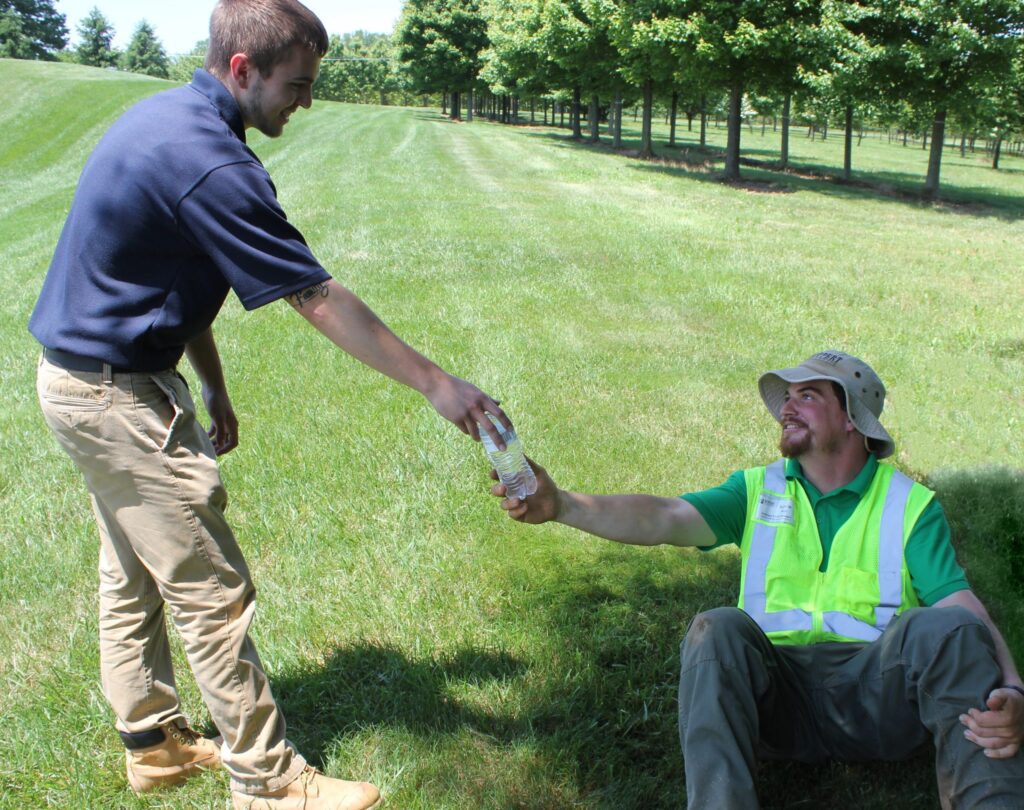By: Dave Sanders, Director of Safety and Risk
 As we head into the heart of summer and temperatures begin to rise, one of the greatest threats our crews in the field face is heat-related illness. While the three forms of heat stress—heat cramps, heat exhaustion, and heat stroke—often go hand in hand, there are a few differences to note: Heat cramps are the mildest form of heat stress, in which the subject experiences muscle cramps, pain or spasms in the abdomen, arms or legs. Heat exhaustion is a condition where the body becomes overheated, during which you may experience a rapid pulse, heavy sweating, dizziness, confusion and nausea. Heatstroke, the most severe form of heat stress, causes the body’s ability to regulate its own temperature to fail completely. Symptoms include red, dry skin with no sweat, seizures or high body temperature. (Be aware that some people are more susceptible to heat-related illness than others. If you have high blood pressure or high cholesterol, are obese or take anti-inflammatory medication for joint pain, then your risk is greater.)
As we head into the heart of summer and temperatures begin to rise, one of the greatest threats our crews in the field face is heat-related illness. While the three forms of heat stress—heat cramps, heat exhaustion, and heat stroke—often go hand in hand, there are a few differences to note: Heat cramps are the mildest form of heat stress, in which the subject experiences muscle cramps, pain or spasms in the abdomen, arms or legs. Heat exhaustion is a condition where the body becomes overheated, during which you may experience a rapid pulse, heavy sweating, dizziness, confusion and nausea. Heatstroke, the most severe form of heat stress, causes the body’s ability to regulate its own temperature to fail completely. Symptoms include red, dry skin with no sweat, seizures or high body temperature. (Be aware that some people are more susceptible to heat-related illness than others. If you have high blood pressure or high cholesterol, are obese or take anti-inflammatory medication for joint pain, then your risk is greater.)
 It’s important to be aware of and look out for symptoms of heat-related illness, but equally as important is taking preventative measures to decrease the chances of experiencing severe heat reactions. Here are a few common sense tips that can help you keep your body temperature in check while working outdoors this summer:
It’s important to be aware of and look out for symptoms of heat-related illness, but equally as important is taking preventative measures to decrease the chances of experiencing severe heat reactions. Here are a few common sense tips that can help you keep your body temperature in check while working outdoors this summer:
- Stay hydrated. This one is fairly obvious, but we can’t stress this enough. When working outside, make sure to drink plenty of water – about one cup every 15 minutes. If you aren’t urinating every two to three hours, you aren’t adequately hydrated.
- Avoid alcoholic and caffeinated beverages. Eliminate or greatly reduce alcohol consumption in the evening and caffeine in the morning. Both cause increased urination, which leads to dehydration.
 Eat salty snacks. Pretzels, potato chips and salted peanuts are great ways to prevent your body’s sodium from being diluted.
Eat salty snacks. Pretzels, potato chips and salted peanuts are great ways to prevent your body’s sodium from being diluted.- Wear lightweight, loose-fitting clothing and appropriate headwear. Wetting clothing is a simple, inexpensive personal cooling technique. It’s most effective in high heat, low humidity conditions since evaporation from the garment would not be restricted. Baseball caps or sun hats that cover your face and neck are always a great option for protective headwear.
- Watch out for each other. Pair up with a “buddy” to remind them to hydrate and watch out for signs of heat-related illness, which can often go undetected.
If you or a coworker recognize signs of heat stress, immediate treatment measures include moving the affected person to a cool place, providing them with water or an ice pack, and in severe cases, seeking immediate medical attention or hospitalization. Heat stress and its symptoms can lead to serious health risks, so it’s always good to familiarize yourself with the warning signs and do your part to stay safe and hydrated this summer!
 Eat salty snacks. Pretzels, potato chips and salted peanuts are great ways to prevent your body’s sodium from being diluted.
Eat salty snacks. Pretzels, potato chips and salted peanuts are great ways to prevent your body’s sodium from being diluted.